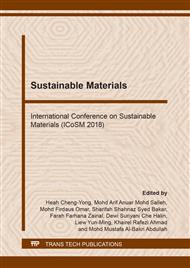p.71
p.76
p.83
p.90
p.96
p.102
p.109
p.115
p.121
Erosive Wear Characteristics of Laser Textured Alumina-Based Coatings for Marine Applications
Abstract:
Micro-groove textured surface of alumina-based ceramic coating is successfully fabricated via laser surface texturing (LST) method. The fabrication of textured surface is aimed to improve the resistivity of components against erosive wear. In this study, a slurry pot testing is conducted to investigate erosion damage on the surface of the textured alumina-based coating. The erosive wear rate of the specimens is determined and the surface morphology of the eroded surface is examined using an SEM. From the results, it is found that the erosion damage of textured coatings is dependent on the impact angles of SiO2 particles. The erosion wear mechanism is found to be varied with the formation of the micro-groove textured coatings. A significant decrease of 45 % in the erosion rate proved that the occurrence of an improved erosion resistance.
Info:
Periodical:
Pages:
96-101
Citation:
Online since:
August 2018
Keywords:
Price:
Сopyright:
© 2018 Trans Tech Publications Ltd. All Rights Reserved
Share:
Citation:


